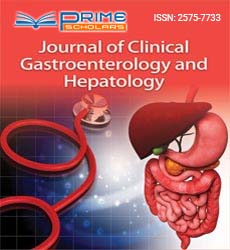Short Communication - (2022) Volume 6, Issue 7
The Symptoms, Causes, Diagnosis and Treatment of Diverticulosis
Peter Walker*
Department of Gastroenterology and Hepatology, The University of North Carolina, USA
*Correspondence:
Peter Walker, Department of Gastroenterology and Hepatology, The University of North Carolina,
USA,
Email:
Received: 29-Jun-2022, Manuscript No. IPJCGH-22-14232;
Editor assigned: 01-Jul-2022, Pre QC No. IPJCGH-22-14232 (PQ);
Reviewed: 15-Jul-2022, QC No. IPJCGH-22-14232;
Revised: 20-Jul-2022, Manuscript No. IPJCGH-22-14232 (R);
Published:
27-Jul-2022, DOI: 10.36648/2575-7733.6.7.35
Introduction
Diverticula are tiny, projecting pockets that can form in the coating
of the structures that support your stomach. The bottom
portion of the digestive system is where they are most usually
discovered (colon). Diverticula are common, especially after the
age of 40, and infrequently cause problems. Diverticulosis is the
condition in which there are diverticula. Diverticulitis is the term
for the ailment that develops when at least one of the pockets
becomes exacerbated, and occasionally contaminated. Extreme
stomach pain, fever, illness, and a clear change in genitalia propensities
can all be symptoms of diverticulitis. Rest, dietary adjustments,
and antibiotics can all be used to treat mild diverticulitis.
Diverticulitis that is severe or keeps coming back may need
to be treated surgically.
Description
Diverticulitis is the “aggravation and disease of” at least one diverticulum,
while diverticulosis is its “presence” (swells in your
colon wall). Diverticulosis is not harmful and does not require
medical attention. Anti-infection medications are used to treat
mild diverticulitis. If problems arise, medical intervention is
needed. Preventing can be accomplished with a high-fibre diet,
exercise, and lots of water consumption. Diverticulitis and diverticulosis
are two conditions that affect the digestive system
(colon). Both provide the diverticula component that is typical.
Diverticula are a minimum of one lump or pocket that form in
the mass of your colon.
Diverticula are air pockets or extended regions that form when a
bicycle tire’s internal air chamber is overinflated. The air pocket
structure, where the elastic is the most brittle, becomes more
unstable due to the expansion in strain caused by an excess of
air being syphoned into the internal cylinder. Additionally, an increase
in internal pressure results in pockets or lumps (diverticula)
forming in the weak area of the colon’s walls. Diverticula can range in size from a pea to a large object. Although they can occur
anywhere along the inner wall of your colon, they are most
frequently found in the sigmoid colon, which has an S-shaped
shape on the lower left side of your body.
Diverticulosis is essentially the development of small little pockets
or lumps in your colon (diverticula). They typically produce
no side effects or require treatment. Diverticulitis can, in any
circumstances, result from diverticulosis. Diverticulitis is a condition
in which at least one diverticulum is inflamed and contaminated.
You could experience several adverse effects, including
pain, nausea, fever, and others. This condition is far riskier and
more dangerous. Diverticulosis affects 10% of people over 40%
and 50% of people over 60, and it is quite common in Western
populations. Diverticulosis affects almost everyone over the age
of 80 and speeds up with age [1-4].
Conclusion
Diverticulosis may be caused by a lack of fibre in the diet, although
this is still unknown to researchers. Lack of fibre leads
to the buildup of waste (obstruction) in your colon. Colon wall
tissue becomes overloaded due to clogging. The diverticula-tiny
pockets frame in weak areas of your colon as a result of
this increased tension. Again, scientists are unsure of the exact
causation of diverticulitis, but they do believe that the germs in
faeces that enter the diverticula are the disease’s first source.
Another theory is that the additional strain on the colon’s walls
causes the real diverticula’s walls to dissolve.
Acknowledgement
None.
Conflict of Interest
Authors declare no conflict of interest.
REFERENCES
- Yang CW, Chen YY, Yen HH, Soon MS (2009) Successful double balloon enteroscopy treatment for bleeding jejunal diverticulum: A case report and review of the literature. J Laparoendosc Adv Surg Tech 19(5): 637-640
[Crossref] [Google Scholar] [PubMed]
- Bhattarai M, Bansal P, Khan Y (2013) Longest duration of retention of video capsule: A case report and literature review. World J Gastrointest Endosc 5(7): 352-355.
[Crossref] [Google Scholar] [PubMed]
- Courcoutsakis N, Pitiakoudis M, Mimidis K, Vradelis S, Astrinakis E (2011) Capsule retention in a giant Meckel’s diverticulum containing multiple enteroliths Endoscopy 43p: e308-e309.
[Crossref] [Google Scholar] [PubMed]
- Giday SA, Pickett-Blakely OE, Buscaglia JM, Mullin GE (2009) Capsule retention in a patient with small-bowel diverticulosis. Gastrointest Endosc 69(2): 384-386.
[Crossref] [Google Scholar] [Scopus]
Citation: Walker P (2022) The Symptoms, Causes, Diagnosis and Treatment of Diverticulosis. J Clin Gastroenterol Hepatol. 6:35.
Copyright: © Walker P. This is an open-access article distributed under the terms of the Creative Commons Attribution License, which permits unrestricted use, distribution, and reproduction in any medium, provided the original author and source are credited.

